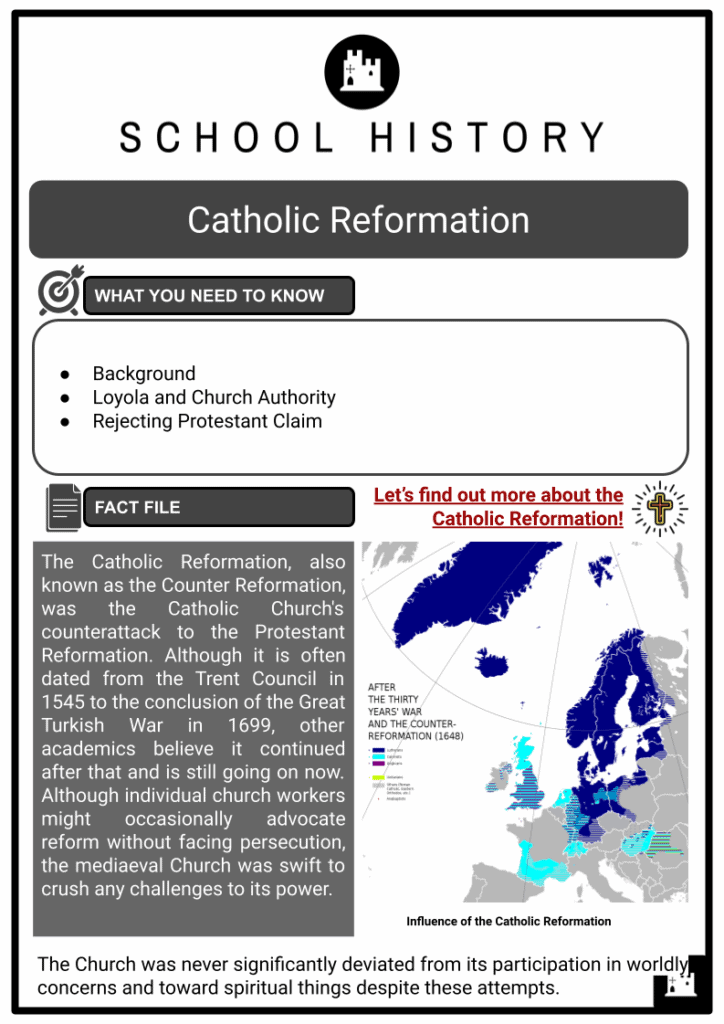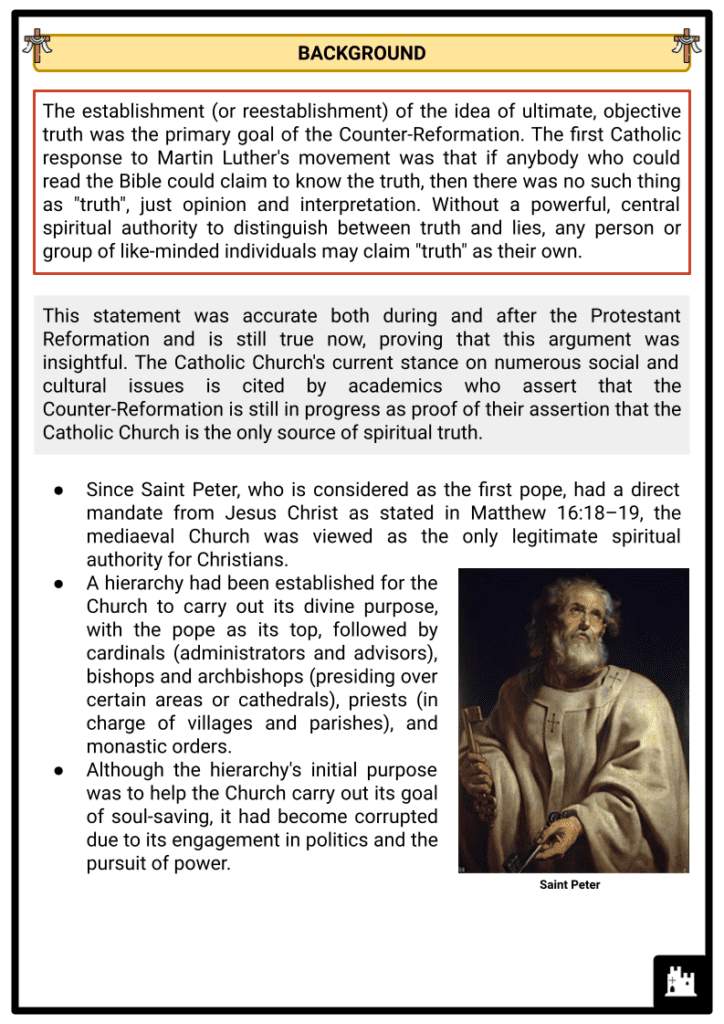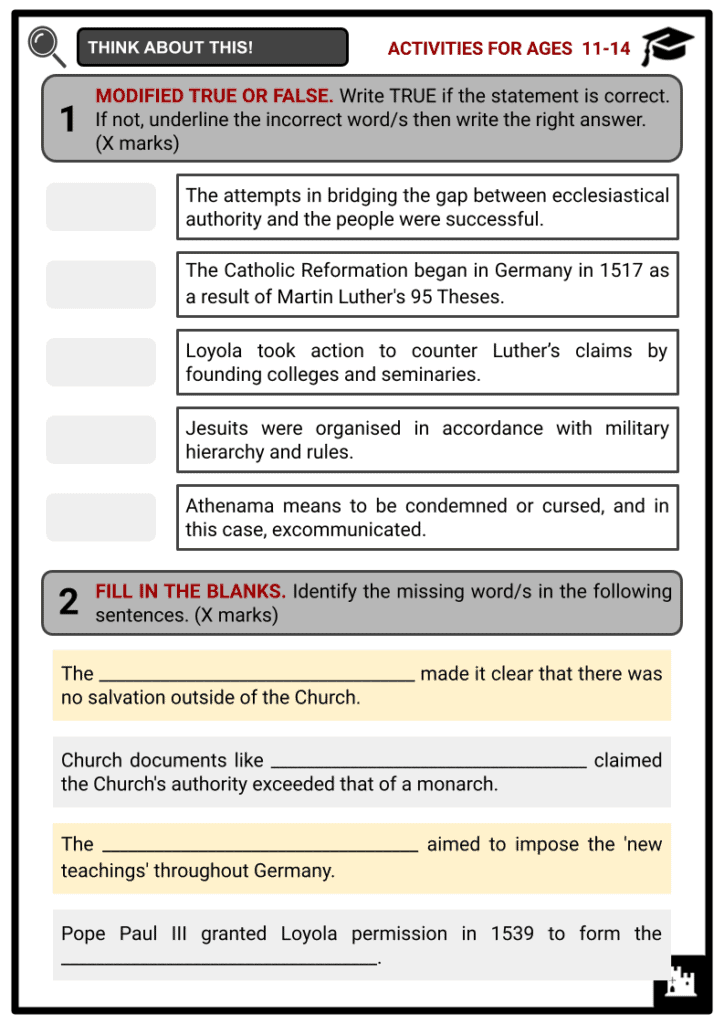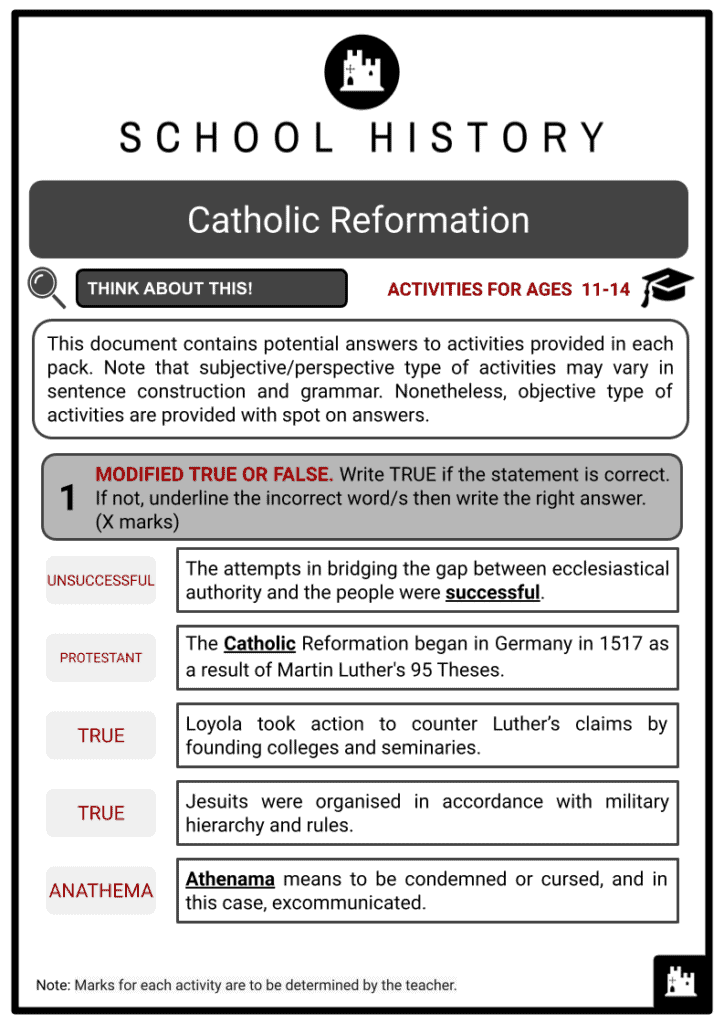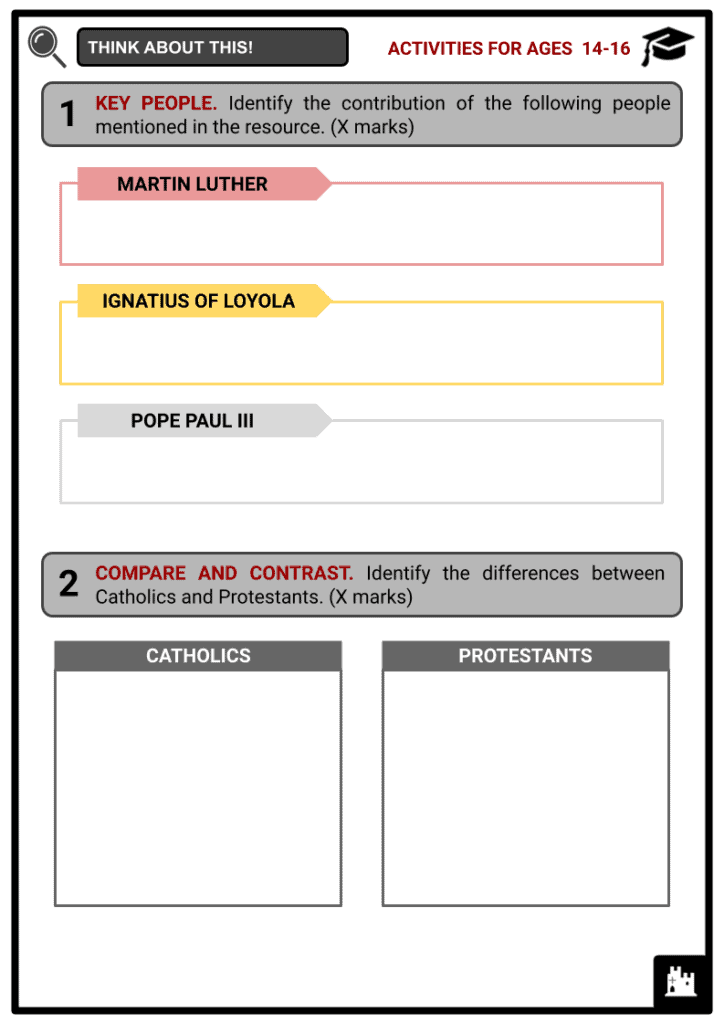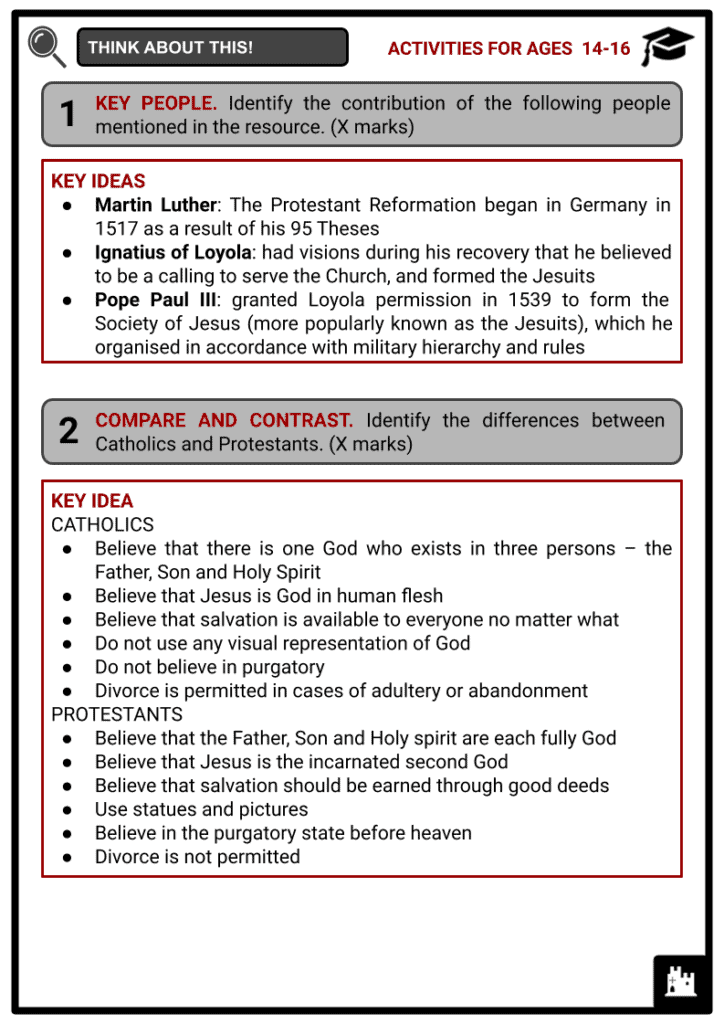Catholic Reformation Worksheets
Do you want to save dozens of hours in time? Get your evenings and weekends back? Be able to teach about Catholic Reformation to your students?
Our worksheet bundle includes a fact file and printable worksheets and student activities. Perfect for both the classroom and homeschooling!
Summary
- Background
- Loyola and Church Authority
- Rejecting Protestant Claim
Key Facts And Information
Let’s find out more about the Catholic Reformation!
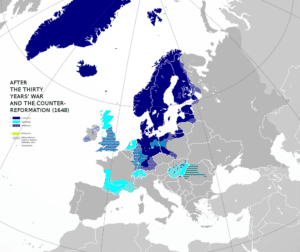
The Catholic Reformation, also known as the Counter Reformation, was the Catholic Church's counterattack to the Protestant Reformation. Although it is often dated from the Trent Council in 1545 to the conclusion of the Great Turkish War in 1699, other academics believe it continued after that and is still going on now. Although individual church workers might occasionally advocate reform without facing persecution, the mediaeval Church was swift to crush any challenges to its power. The Church was never significantly deviated from its participation in worldly concerns and toward spiritual things despite these attempts.
BACKGROUND
- The establishment (or reestablishment) of the idea of ultimate, objective truth was the primary goal of the Counter-Reformation. The first Catholic response to Martin Luther's movement was that if anybody who could read the Bible could claim to know the truth, then there was no such thing as "truth", just opinion and interpretation. Without a powerful, central spiritual authority to distinguish between truth and lies, any person or group of like-minded individuals may claim "truth" as their own.
- This statement was accurate both during and after the Protestant Reformation and is still true now, proving that this argument was insightful. The Catholic Church's current stance on numerous social and cultural issues is cited by academics who assert that the Counter-Reformation is still in progress as proof of their assertion that the Catholic Church is the only source of spiritual truth.
- Since Saint Peter, who is considered as the first pope, had a direct mandate from Jesus Christ as stated in Matthew 16:18–19, the mediaeval Church was viewed as the only legitimate spiritual authority for Christians.
- A hierarchy had been established for the Church to carry out its divine purpose, with the pope as its top, followed by cardinals (administrators and advisors), bishops and archbishops (presiding over certain areas or cathedrals), priests (in charge of villages and parishes), and monastic orders.
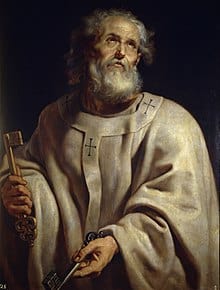
Saint Peter - Although the hierarchy's initial purpose was to help the Church carry out its goal of soul-saving, it had become corrupted due to its engagement in politics and the pursuit of power.
- The Unam Sanctam, which made it clear that there was no salvation outside of the Church and that everyone, believers and nonbelievers, should be subject to the pope, God's representative on earth, was published in the early 14th century. By the 8th century, Church documents like The Donation of Constantine claimed the Church's authority exceeded that of a monarch.
- The mass of the European populace felt no personal connection to the pope's decrees, the Bible, prayers, or services since they did not comprehend Latin, despite the fact that they were delivered to the people and passed through the hierarchy in Latin. Poorly trained priests, bishops, cardinals, and even popes who were more concerned with promoting their personal comfort than spreading the Christian message made the gap between the Church leadership and congregations even greater.
LOYOLA AND CHURCH AUTHORITY
- The attempts of men like Valla and Erasmus to return the Church to its purpose were unsuccessful in bridging the gap between ecclesiastical authority and the people. They also did not stop clerical abuses of power or government initiatives that placed a price on salvation. One of these was the selling of indulgences, writs that promised to shorten the period of time spent in purgatory after death and brought in a significant sum of money for the Church. The Protestant Reformation began in Germany in 1517 as a result of Martin Luther's 95 Theses; meanwhile, in Switzerland, Huldrych Zwingli started his own reforms in reaction to comparable injustices.
- Similar movements were sparked by Luther and Zwingli's activities in Spain, Italy, France, the Netherlands, and Italy by 1522. After failing in its attempt to suppress Luther, the Church debated reformers and wrote pamphlets to discredit their claims to legitimacy.
- Although the majority of people in Europe were illiterate at the time, bestsellers on this new religious controversy were read in public, which helped the Reformation gain more support because it allowed people to connect directly with their faith and at first seemed to promise a new order in which all social classes would be equal or, at the very least, the lowest class would not have to bear the financial burden of the others.
- The Knights' Revolt (1522–1533), which aimed to impose the 'new teachings' throughout Germany, and the German Peasants' War (1524–1525), an effort to question the existing quo, are examples of how the Reformation's message resonated with those who felt marginalised by the Church and social hierarchy.
- In order to address these problems, Charles V, Holy Roman Emperor, called the Diet of Augsburg in 1530.
- This was when the Protestants of Germany delivered the Augsburg Confession and the Catholics responded with the Confutatio Augustana.
- The opposite side's confessions of faith were rejected by both sides, and as a result, the confessions served as focal points for the opposing viewpoints.
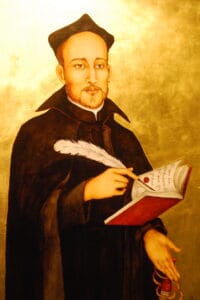
Ignatius of Loyola - Ignatius of Loyola, a Basque soldier who had been wounded in the Battle of Pamplona in 1521, had visions during his recovery that he believed to be a calling to serve the Church. In 1534, he gave up his old life, began studying theology, and made a promise with six others to protect the Catholic Church against heresy, preach the idea of universal salvation, and assist it in fixing its flaws. Pope Paul III granted Loyola permission in 1539 to form the Society of Jesus (more popularly known as the Jesuits), which he organised in accordance with military hierarchy and rules.
- Loyola backed the argument initially given by Johann Eck against Luther and Andreas Karlstadt during the discussion in Leipzig in 1519: if there was no central spiritual authority to define 'truth,' then anyone's interpretation of 'truth' could be considered valid, indicating that there was no truth, only opinion. Because the Bible was not just any book and its lessons were more intricate than they first appeared, Eck had asserted that only the Church was qualified to interpret the Bible. The work needed to be interpreted and its message preached to the laypeople by trained theologians.
- Insisting that one may be saved before God with nothing more than personal faith and the Bible, Luther had dismissed this assertion as another another ruse by the Church to hold onto power. In addition to rejecting Luther's assertion, Loyola took action to counter it by founding colleges and seminaries where priests would get training in biblical interpretation and ministry in line with the Church's doctrine that one was only justified by obedience to Catholic teachings.
REJECTING THE PROTESTANT CLAIM
- Anathema means to be condemned or cursed, and in this case, excommunicated. The purpose of the Council of Trent was to uphold Catholic theology, correct errors and excesses, and denounce the doctrines of the Protestant sects. Protestant representatives were welcomed, but it was made clear that they would not participate in voting on the decrees. The council refuted Luther's assertion that salvation came from faith alone and upheld the Church as the final arbiter of how the Bible should be understood and what it teaches.
- Traditions including the reverence of saints and relics, knowledge of the Eucharist, using Latin to celebrate Mass, and the advantages of iconography and music in worship were modified (though not eliminated), as were the sale of indulgences.
- Although serious, The Council of Trent's reforms also sought to undermine Protestant criticism of the Church and highlight key differences between Catholic and Protestant interpretations of Christianity.
- The foundation for the Catholic assertion that the Bible is the only source for judging spiritual truth was laid by the rejection of Luther's "faith alone" and "scripture alone" claims.
- By 1545, there were numerous distinct Protestant sects, each of which asserted that it adhered to "true Christianity."
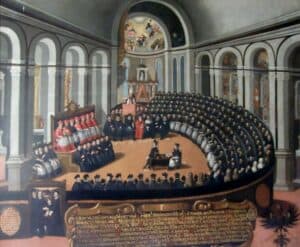
Council of Trent - The Church responded that if they all claimed to be correct, then none of them could be, whereas the Church—which received its founding directive from Jesus Christ himself—could not possibly be incorrect.
- The Jesuits and other Catholic clergy used classical literature, particularly the discipline of philosophical scepticism as developed by Sextus Empiricus and based on the ideas of the sceptic philosopher Pyrrho of Elis, in order to challenge the Protestant claims of "faith alone" and "scripture alone." According to Pyrrho, one should avoid forming judgments or drawing conclusions based solely on their senses and instead not take the judgments or conclusions of others too seriously.
- The Church asserted that the claims made by the Protestant leaders were false since they were nothing more than opinion by quoting directly from Empiricus, who wrote extensively on the issue. To emphasise Pyrrho's assertion that every debate is only opinion, cannot be objectively defined as being connected to "truth," and is, thus, nothing to engage in or become upset about, Empiricus argues, "To every argument an equal argument is opposed." The Church then asked, "What if there was someone or something that could resolve an argument objectively, so it was no longer a matter of opinion but truth?"
- They then responded with a scripture verse: "Trust in the Lord with all your heart, and lean not on your own understanding" (Proverbs 3:5). They asserted that the Protestants were leaning on their own understanding and had replaced truth for lies, but the Church, as God's representative on earth, could be relied upon to communicate the truth regarding the essence of the divine. This explanation served as the foundation for numerous Council of Trent decisions, including the Inquisition and the Index of Prohibited Books, and is the basis for Loyola's claim that one should accept white as black if the Church says it is. The Church was not going to make the same mistake twice after allowing its authority to be questioned in 1517. Particularly the Jesuits promised to protect that authority and defend the Church at all costs.
Image Sources
- https://upload.wikimedia.org/wikipedia/commons/thumb/6/6b/The_Counterreformation.svg/1000px-The_Counterreformation.svg.png
- https://upload.wikimedia.org/wikipedia/commons/thumb/2/2d/Pope-peter_pprubens.jpg/220px-Pope-peter_pprubens.jpg
- https://upload.wikimedia.org/wikipedia/commons/5/51/Ignatius_Loyola_-_Loyola_Academy.jpg
- https://upload.wikimedia.org/wikipedia/commons/7/7e/Concilio_Trento_Museo_Buonconsiglio.jpg

